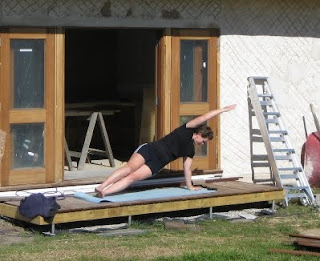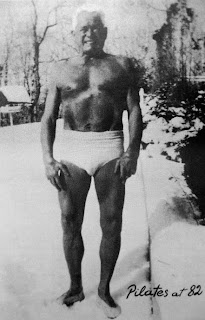Me doing a Pilates "mermaid" on the sunny deck of the
not-quite-finished strawbale cottage
Pilates in the sunshine is one of Louis's favourite things, too
*****
When it comes to running, I'm more wombat than cheetah. I can trundle along and cover a reasonable amount of ground if I have to - but, Baby, I was not born to run.
Nevertheless, several years ago I used to go for a 3.5km jog most mornings - and all too often, by mid afternoon, I'd have a headache so bad that I had to either lie down or risk falling over.
The headache situation became ridiculous in fairly short order, so I went to the local physiotherapist and described the exact nature of my headaches to her. She listened and nodded, and told me that she was going to attempt to reproduce my headache.
Hmmmm ... OK...
She stuck her thumb into the right side of my neck just under the base of my skull, and bang! Instant headache. This came as no surprise to her - the pain I had described was being caused by muscle tension interfering with a particular nerve in my neck.
Then she got me to demonstrate my walking and jogging for her, and her immediate response was: "Gee, your legs are very different lengths, aren't they?"
What? Really? My legs are different lengths?
She measured my legs from hip to ankle, and sure enough, the right one was almost an inch shorter than the left.
You might be wondering how on Earth I could not have noticed such a large discrepancy in my legs ... but my legs have always just been my legs, and I simply have no experience of what it's like to have legs of equal length.
The physio loosened up my neck for me, gave me a few neck stretches to do, and strongly recommended Pilates. I was so impressed with her diagnosis of my problem that I figured her recommendation of Pilates was probably good advice. In fact, it was one of the best pieces of advice I think I've ever received.
Brooke Siler's amazing "Pilates Body"
I went to the nearest bookshop and was lucky enough to stumble upon Brooke Siler's excellent book: The Pilates Body - "the ultimate at-home guide to strengthening, lengthening and toning your body - without machines".
I just can't praise Siler's book too highly, and I don't think it's an exaggeration to say that it changed my life.
Siler's book is chock-a-block with clear photographs showing each stage of each exercise. The accompanying text is detailed and precise, so it allows you to get started with Pilates in the time it takes to read the introductory chapter - with no expensive equipment or classes necessary.
Pilates - yoga for inflexible atheists?
For people who have no idea what Pilates is, I often describe it as yoga minus the spirituality. I don't have much experience with yoga, but I have found that I can't spend 5 minutes researching yoga without coming across references to "spiritual energy" and other kinds of mysticism.
Another point of difference between yoga and Pilates: I've read that, while Joseph Pilates' exercises were strongly influenced by yoga, yoga is more about stretch, while Pilates is more about strength.
I enjoy thinking of Pilates as yoga for atheists - but apparently some Christians approve of Pilates because, unlike yoga, it is "spiritually neutral". Yet, they warn, "there are reasons for Christians to exercise discernment when deciding whether to participate in Pilates exercises", because some Pilates instructors "drink deep from the New Age well"(!)
On the other hand, some long-term devotees of Pilates are appalled by suggestions that Pilates lacks spirituality. According to them, "Pilates has been practically messianic in its spirit and still is for those who understand it. Joe was trying to change the world! We, his followers, were referred to as his disciples."
I'm not convinced that Joseph Pilates' "disciples" help their cause by making Pilates sound like some sort of religious cult. But even I have been tempted, on occasion, to refer to the Pilates exercise program as miraculous. In my experience, it's really that good.
Why I love Pilates
When I first took a look at the Matwork exercises in Brooke Siler's book, I thought: "Easy."
Wrong!
It turned out that I couldn't do even the most basic exercises without resorting to the Siler-approved cheats (she calls them "modifications") for all the poor blobs who are too weak to hold our legs off the floor for a count of 100, or are too inflexible to circle our legs in the air without bending at the knee.
So, the exercises are challenging enough for beginners to be ... challenging. And yet they're easy enough to be achievable with just a few sessions' worth of honest effort.
And once you master a Pilates exercise, my experience is that your body retains a remarkable muscle memory of that exercise, meaning that you'll never find it as hard in the future as you found it the first time you attempted it.
I haven't dedicated a large amount of time to Pilates by any stretch of the imagination: I usually spend about 10 minutes per session, several times a week, doing the first five exercises in the Pilates Mat Program. I don't find it onerous or time consuming - on the contrary, I always feel much better for having done it.
But sometimes, I don't do Pilates for a while - and then I really notice it, because my back starts feeling like a rusty old gate when I get up in the morning. So, back to the mat I go, and the problem can usually be resolved in a couple of minutes with a quick warm-up and a "rollover" or three:
As Joseph Pilates said: "Physical fitness can neither be achieved by wishful thinking nor outright purchase". But if you're willing to invest some time and effort, the rewards can be amazing.
For proof, just take a look at Joe Pilates at the age of 82:
"In 10 sessions, you will feel the difference,
In 20 sessions, you will see the difference,
In 30 sessions, you’ll have an entirely new body" Joseph H. Pilates






I watched my father struggle his entire life with a bad back. Spending thousands of dollars on physio and chiropractic. These things helped, but they never fixed the problem.
ReplyDeleteThen at age 15 I got my first back problem. For the next 20 years I suffered with it. Going to physio when it got bad and living with it when it wasn't.
Then, Sam introduced me to Pilates. Now I have a different life with no back trouble as long as I do some pilates semi-regularly.
If you have a bad back, then all you need to do to fix it, is (as Sam says) do the first few moves of the Pilates Mat Program every day or two and it will fix your back _forever_.
Hehe ... do we sound like an infomercial?
ReplyDeleteIs Joseph Pilates really the Messiah?
His exercise regime .. just .. works.
I knew it! you two have been teaching that dog yoga. You want to take it easy there or pretty soon he will be wanting a gym built onto the cottage, then he'll be demanding his own bike. :-)
ReplyDeleteReally awesome blog. Your blog is really useful for me. Thanks for sharing this informative blog. Keep update your blog.Pilates insurance cost
ReplyDeleteIt is really very important to get good guide for Pilates online. Thanks for sharing this informative information with us.
ReplyDeleteNice Post!
ReplyDeletePilates is a muscle strengthening exercise that is highly recommended for postural flexibility and alignment. Even though the exercises work in your whole body, it mainly targets your core. It is not necessary to get any sort of equipment for Pilates classes. The moves included in this low impact exercise will involve breath control and slow, precise movements. It also helps in stabilizing your body and improves your performance at everything. Your efficiency will surely increase after regular pilates classes. You need to do Pilates every day for at least forty-five minutes.
Thanks for this great idea. I will definitely use it in class. Keep it sharing.
ReplyDeleteZoom knee rehab
Cool
ReplyDelete